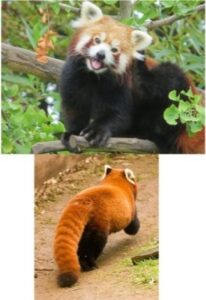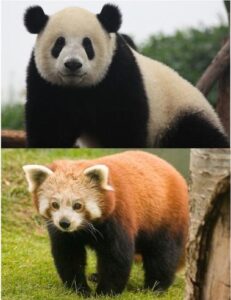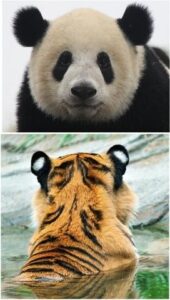Note to readers: Biological Expositions is a series of blog-posts each of which is equivalent in content to a book chapter. If a bio-bullet is likened to a starter, our routine blog-post could be seen as a light lunch and a Biological Exposition blog-post as a three course meal. We look forward to your comments on this series.
Striking black and white. A living logo. Improbable, unforgettable – and perhaps inexplicable.
Why, in biological terms, is the giant panda so boldly black and white? Who has ever come up with a plausible explanation? The species seems to mock our grasp of evolution with an image as puzzling – in terms of adaptation to its habitat and niche – as it is graphic.
The lack of coherent hypotheses out there indicates that the usual experimental approaches have failed even the experts in this case. With everyone nonplussed, the biological function of the colouration of the giant panda may never be explained unless someone does some lateral thinking.

Figure 1. Giant panda and suricate (Suricata suricatta), showing the anthropomorphic appeal of dark ocular patches that seem to enlarge the eyes [photos by M. Field and Cliff1066 under Creative Commons licence 2.0].
So let’s think laterally from two angles.
Firstly, let’s extrapolate from the patterns found among bears in general, inferring clues to the logic behind the species with the most extreme colouration. Secondly, let’s compare the giant panda with its closest ecological relative, the smaller, less celebrated, but likewise bamboo-eating red panda – which happens not to be a bear and belongs to a different family despite living in similar habitat and having a similar diet.
Now, the bear family expresses two patterns more consistently than any other family does in the carnivore order of mammals. Firstly, all bears except for the brown bear tend to be conspicuously dark or pale overall. Secondly, the dark species tend to have pale exclamation marks in various configurations on the chest, which are exposed when the animal rears up in confrontation. We’ll assume that these function as warning signs.
Viewed from this angle, the fact that the giant panda is mainly black and white is not in itself odd for a bear. Nor is it particularly odd that the face is pale, because most species of bears have rather pale muzzles, in some cases set off rather conspicuously from dark pools around the eyes. What is odd is that the giant panda has large patches of black combined with an otherwise white coat. Other bears tend to have either dark or pale tones dominant, i.e. no large blocks of dark or pale. And no predominantly pale bear has dark markings on its fur. The retention of a brownish colour on its posterior suggests that the giant panda is not completely different, just extreme in its balance of dark versus pale.

Figure 2. Giant panda, showing the blurring of dark and pale on the seldom-photographed hindquarters [photo © Ted Negrelli].
Our interpretation of the relatively uniform coats of other bears is that these formidable and essentially solitary mammals, all of which rely on smell and none of which hunts by stealth, need neither cryptic colouration nor social colouration. So it seems fair to assume that the giant panda, likewise, isn’t coloured for crypsis or social communication. That would mean that the real function of the checker pattern of the giant panda is unlikely to be camouflage in a patchily snow-covered landscape as a few authors have previously suggested.
Now something that really is odd about the giant panda – and we seem to be the first to notice – is that this is the only bear lacking any pale blaze on its dark chest.

Figure 3. Asian black bear, sloth bear, sun bear, spectacled bear and giant panda, showing the pattern of black and white typically presented by bears in upright confrontation [photos by (clockwise from bottom left) Socialbedia, G. Nicolas, M. Ijsendoorn-Kuijpers and Tambako the Jaguar under Creative Commons licence 2.0 and © Sarah E. Truman (www.sarahetruman.com)].
Where have our comparative observations brought us so far? To a suspicion that the giant panda either differs from other bears of similar body size in lacking a warning pattern in confrontation, or has expanded this exclamation mark to convert the whole front to black-and-white.
The latter seems the more likely for several reasons. Firstly, the hindquarters of the giant panda, which aren’t seen in confrontation, have a blurred pattern in which the tonal contrast is relaxed. Secondly, when the giant panda rears up, the black of the chest, shoulders and forelegs contrasts sharply with the mainly white face and belly. Thirdly, the blackness of the fur around the eyes is only the starkest expression of a pattern shared in subtle form with other bears – particularly the partly bamboo-eating spectacled bear of the Andes. So the whole black-and-white front of the giant panda is plausibly an extension of – to the point of substituting – the chest pattern in other bears.
Why is the giant panda black and white? So far, our argument is leaning towards warning colouration.
Now let’s examine the red panda, which is neither bear-size nor a bear, but is ecologically related to the giant panda and shows convergent colouration in its dark legs and the difference between the conspicuous anterior, with a noticeably pale face and dark markings on the ears and below the eyes, and inconspicuous posterior, with a brown, cryptically coloured rump and tail.
The red panda differs from bears in two prominent ways relevant to understanding colouration in pandas. Firstly, its starkly dark-and-pale ears are more conspicuous, relative to body size, than in any bear. Secondly, it takes a pattern of darkness under the eyes that is present in subtle form in most bears and expresses it more clearly than in any bear apart from the giant panda.

Figure 4. Red panda, showing the conspicuousness of the ears both in confrontation and when viewed from behind [photos by Marshmallowbunnywabbit and A. Muldowney under Creative Commons licence 2.0].
Ears with dark and pale fur arranged in a striking pattern are nothing new in the carnivore order. However, of all the 280 or more species in this order, the red panda has among the most conspicuous ears relative to the rest of the body and head. This is because the ears project sharply from the silhouette, have an eccentric lower tassel, have whitish rims and points, and present a contrast of dark versus pale on both the front and the back surfaces. Indeed, the red panda takes all the various ways in which ears can be conspicuous across the spectrum of other carnivores, and combines them in one species. The resulting ‘ear flag’ sets the red panda particularly apart from non-panda bears, which have no particular auricular colouration to speak of – although blond ears can be among the few highlights on the dull brown coat of the adult brown bear.
So, why is the giant panda black and white? Now we see that giant panda and red panda, although belonging to different families, happen to converge in having conspicuous ears by different patterns. For among all bears, it’s the giant panda that has the most conspicuous of ears. And the pattern in the red panda once again hints that the black upstanding ears on a white head of the giant panda aid conspicuousness rather than crypsis.
Our observations on the ears may seem ambivalent for our suggestion of warning colouration in the giant panda. And our line of deduction may, to some readers, seem to be as tenuous as bamboo scaffolding on a building site. But please stay with us because nobody has yet come up with a springier solution and we are, after all, trying to deconstruct one of the most recognisable animals on Earth. It’s worth a venture into the void at the Bio-edge for the sake of an alternative logic.
Returning, then, to our rationale: the fur around the eyes presents a parallel to the fur of the ears. Although the dark patches associated with the eyes of the giant panda are more defined than those of the red panda, there’s a similarity in orientation and width there. This means that the ocular patches of the giant panda are starker than those of any other bear.
Which message are pandas sending with this ocular exaggeration? Both species could be wearing masks but we’ll argue that the opposite is the case, at least in the giant panda.
Dark ocular patches, bands and stripes are more common in carnivorous mammals than in herbivorous mammals. Depending on the details, they can hypothetically aid either crypsis or conspicuousness. And where they aid conspicuousness, this is usually indirectly by drawing attention away from the eyes towards a whole-body pattern of contrasting dark and pale, as typified by skunks. Indeed, all noxious species of the mustelid family seem to mask their eyes in various designs. Perhaps it serves the untrustworthy image of bad-smelling members of the carnivore order to hide their eyes even as they advertise their noxiousness by means of black-and-white flags. This must seem sinister or at least confusing to a large antagonist.

Figure 5. Giant panda and red panda, showing that both species have conspicuous ears and similarly oriented dark patches associated with their eyes [photos by A. Muldowney and G. de Rozze under Creative Commons licence 2.0].
Based on our interpretation of eyemasks in the carnivore order, it might be consistent to suggest that pandas hide their eyes in combination with otherwise conspicuous colouration as a form of warning. By this view, the giant panda would be like a giant non-noxious skunk. However, we suggest that the giant panda is one species – and possibly the only one in its order – that uses ocular patches in a different way, not hiding its eyes but instead emphasising them in a false stare. This is a subtle difference from the mustelid pattern but would also be calculated to confuse enemy species in confrontation.
As observed by humans, the dark ocular patches of the giant panda seem not to be a mask but rather the opposite: larger-than-life eyes. The species panders, as it were, to our biases by being rotund and furry, with a broad face and ocular patches that face forward as in humans and simulate the proportionately large eyes of youth. This anthropomorphic impression is of course psychological, because the real eyes of the giant panda, like those of all bears, are in fact disappointingly small and piggy.
So, why is the giant panda black and white? Let’s clinch our explanation boldly.
Please remember that the most dangerous predators historically affecting the giant panda tend to be nocturnal, particularly marginal populations of the tiger and leopard. How would large felids perceive the giant panda in a sudden confrontation in the gloom?
In light too dim to show the real eyes but adequate to show the white face, what’s likely is that the dark ocular patches of the giant panda would exaggerate rather than hide the eyes. A large felid would probably not see the eyeball of the giant panda, which is inconspicuous even in bright light because the iris is dark and the eyewhites are hardly exposed. And a snarl would not be particularly impressive even if the relatively short and blunt canines of the giant panda were visible against its whitish muzzle. But the staring ocular patches, seeming to be the eyes of a larger-than-life adversary, might sway the risk-assessment of the predator. When a large felid confronted the giant panda, something that would seldom occur because of the natural scarcity of this bear compared to common prey such as sambar deer, takin and wild pig, it was likely to be browbeaten by the glaring dark orbs on a stark, intimidating face.
If anyone doubts that large felids are sensitive to rounded patches in contrasting black and white, have a look at the pattern on the back-of-ear of the tiger itself.
So, we suggest that the giant panda has warning colouration of an unnamed type. This species does not warn of any noxious capacity, as in the case of skunks and the honey badger. But it plausibly warns of the dangerous claws of all bears, and jaws more muscular than in any other bear because of the power needed to mince bamboo. The giant panda is poorly described by the word ‘aposematic’ because its vice-like defensive mechanism – hugging and bulldogging – is a corollary to its foraging habits rather than being specially defensive like the sprays of various mustelids. However, the form of warning colouration in the giant panda would make sense for a slow but robust species that would be unlikely to survive predation pressures without some compensation for the limitations imposed on its rate of reproduction by its poor diet of bamboo. That antagonistic compensation is, arguably, its unmistakable colouration.
Since our argument is based on extrapolation of trends in comparable species, it seems only fair that it should meet its own standards. Is there any other mammal worldwide – apart from the related spectacled bear – that shows a similar pattern for similar reasons but by independent evolution?
Well, maybe certain South American anteaters.

Figure 6. Giant panda and tiger, showing similar graphic design in the ocular patches of the bear and the back-of-ear patches of the large felid [photos by G. de Rozze and Tambako the Jaguar under Creative Commons licence 2.0].
Anteaters, like pandas, flee and reproduce slowly owing to an energy-poor diet, and are therefore likewise vulnerable to predation. Although they lack teeth, their foreclaws are particularly lethal because of the extraordinary power needed to excavate their main diet of social insects from wood and baked earth. Although small-brained and small-eyed, anteaters can be lethal in a vice-like clinch. The giant anteater again presents large felids with a dark patch on a whitish background – in this case on its wrist – to warn the would-be predator that sluggish does not necessarily mean vulnerable. Is it mere coincidence that the foreleg of the giant panda in our photograph almost resembles the head of the giant panda?
So, why is the giant panda black and white?
The giant panda will continue to be seen as an icon of conservation. It has also perhaps been a symbol for inexplicable colouration in animals – until now. We challenge readers to offer a better adaptive explanation for the colouration of the best-known nearly-extinct mammal than a visual warning directed against the tiger and the leopard.

Figure 7. Giant anteater and northern tamandua, showing contrasting colouration reminiscent of giant panda [photos by D. van Made and M. Thyssen under Creative Commons licence 2.0].
And we also issue two other challenges. Firstly, who can coin a biological term for the type of aposematism we’ve proposed for giant panda and giant anteater? And secondly, who can capture on camera the irony of an encounter between the spectacled bear – closest relative of the giant panda in Colombia – and the northern tamandua, which possibly occurs in the same habitat but is as reminiscent of the giant panda in its pied colouration? Please join in the discussion in the comment stream.
Acknowledgements:
We thank Michael J. Bamford for his generous discussion during the writing of this essay.

